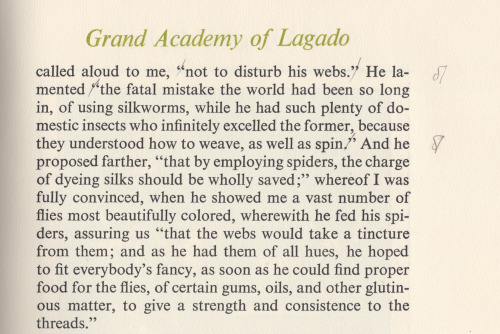#angelica press
angelica’s unusual laputa
i stumbled across a sweet edition of part three from jonathan swift’s 1726 Gulliver’s Travels, designed & illustrated by warren chappell: the angelica press edition of Gulliver’s Travels : A Voyage to Laputa [ nyc, 1976]. the book includes preface & afterword on swift, both by house proprietor dennis j. grastorf; in his introduction, grastorf describes chappell’s creation method for the illustrations—clever combination of letterpress, pen & ink, photography (1st illustration frontispiece & 2nd illustration): grastorf dubs this two-color chiaroscuro. i presume grastorf may also have been editor, & author of the colophon (3rd illustration).
perceiving the text set comfortably large i felt immediately attracted to a read; but was mystified to learn from the colophon that the text is set 12pt times new roman: upon analysis i make it 13/14, but it feels larger. admittedly, the 1970’s were the height of mini-computer driven film composition for offset litho: either the photo-typesetter manufacturer’s version of times was, somehow, large on the body or chappell’s 12pt specification was subjected to scaling by the compositor. in any event, i applaud the admixture of times & perpetua. i am, however, amazed that uppercase display is not letterspaced (aesthetically balanced)—absence of this in chappell’s work i have never noticed. perhaps the compositor had yet to unravel all the mysteries of his machine.
during the read i grew increasingly aware of anomalies of punctuation, first noticing quotation of statements, i.e. within inverted commas (e.g. 4th illustration); but these are reported statements, not direct speech—the editor not so daring as to recast the clauses. i also found colon & semicolon where simple comma is expected; checking several instances against a bona fide text my observations were confirmed: the editor embarked upon a bold new logic for punctuating swift, &, perhaps, overwhelmed by swift’s descriptions of the academicians of Lagado felt an urge to up his game, be more adventurous.
Post link




